Rising Root Greens | Backyard Gate
By:
Timothy Hammond
Ideas for rising root greens
I like rising root crops. It’s an journey and a treasure hunt: You begin with a tiny seed or root, and earlier than it you might be pulling on the tops, hoping for a very good yield. Let’s begin with the fundamentals for beets, radishes and carrots, then scroll down discover ways to develop a number of extra of my favorites: ginger, turmeric and horseradish.
Observe Huge Metropolis Gardener
@BigCityGardner on Instagram
Huge Metropolis Gardener weblog
Fundamentals for rising beets, radishes & carrots
1. Plant at the most effective time
Beets, radishes and carrots develop greatest when soil and air temperatures are between 50 and 75 levels F. For fall harvest, plant in late summer season and proceed to take action all through the autumn months. They’re comfortable rising in full solar and even half shade. This makes them nice candidates for interplanting with taller crops, which is able to assist shield tender seedlings from sizzling temperatures within the South.
2. Begin with nice soil
Free, well-drained soil is the important thing to producing giant, properly formed root crops. Earlier than you plant, be sure you take away rocks and particles that may inhibit root formation. I additionally wish to work compost or a balanced slow-release fertilizer into the soil earlier than I plant. These crops are versatile and you may develop them within the floor, in raised beds and even in containers. For beets and radishes and a few shorter carrot varieties, search for a container round 12 inches deep. For longer carrots I like to recommend at the least 18 inches deep. The broader, the higher.
3. Use the furrow methodology for root greens
Beets, radishes and carrot crops develop properly when planted utilizing the furrow methodology, which is planting in a mounded row: If you run a trowel or hoe throughout your mattress, you create a mound on both facet. As a substitute of planting within the trench, plant within the free soil of those berms. That is the other of what you do for many crops.
You May Additionally Like:
How Many Greens to Develop
7 Simple Vegetation to Begin from Seed
Small Vegetable Backyard Design Concepts
4. Give seeds the fitting spacing
To plant, gently press the deal with of a long-handled device into the moist soil earlier than seeding. Then sprinkle the seeds about an inch aside into the imprint and canopy them with a skinny layer of compost. To stop the soil from forming a tough crusty layer, attempt protecting your newly seeded row lined with a tarp or burlap sack simply till they sprout. As soon as the seedlings attain 2 to 4 inches tall, it’s time to skinny them. Forgetting to take away a few of the seedlings will result in overcrowding, which causes poor root improvement.
Thinning seedlings
To skinny, seize a pair of snips or scissors and minimize out sprouts till you’ve achieved the spacing advisable on the seed packet. Strive to not take away the stems by pulling them out. You may uproot and disturb the foundation zone for a number of vegetation should you do. I add the thinned sprouts to salads and smoothies.
5. Harvest root greens early and sometimes
Harvest these vegetation at varied phases throughout the rising season. You don’t want to attend till they’re totally mature. When you’ve by no means tasted a child beet, radish or carrot, attempt one and thank me later. The flavour is in contrast to every other. Sadly, child root crops don’t retailer properly. For approximate maturity dates, seek advice from the seed packets. The phrase “prepared to reap XX days” refers back to the days after germination in order that’s when counting begins. I like to reap after I see the shoulders of the crop sticking up from the soil.
Though root crops wish to have common moisture as they’re rising, cease watering because the roots attain maturity, as this could trigger them to crack. You’ll want to try extra detailed recommendations on my favourite root crops as you learn on.
You May Additionally Like:
Vegetable Backyard Plan with Curb Attraction
How you can Develop Garlic
How you can Develop Radishes in Spring or Fall
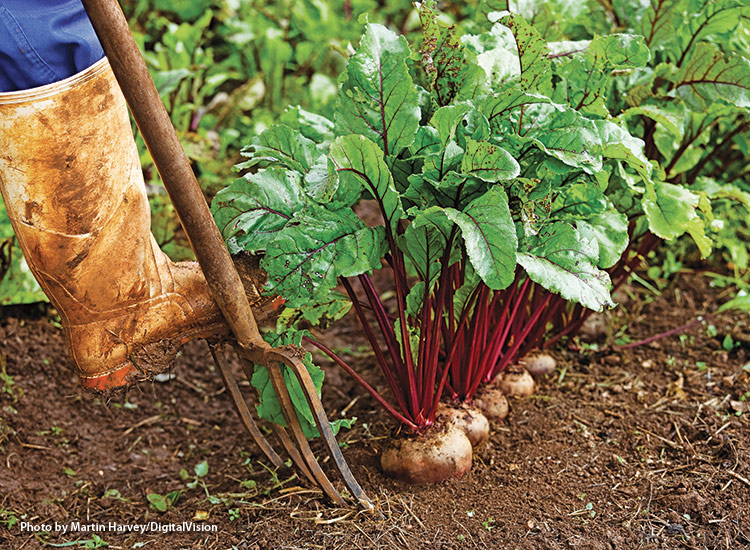
Ideas for rising beets
Beets (Beta vulgaris)
- Every beet seed produces two to a few sprouts.
- Soak beets seeds in water for as much as 24 hours earlier than planting to extend germination charges.
- Beets develop greatest in cooler temperatures. To maintain soil cool, apply a layer of natural mulch as soon as beets have sprouted.
- Strive rising beet greens. These varieties solely produce the inexperienced tops and no roots. ‘Recent Begin’ and ‘Recent Pak’ are two of my favorites.
- Basic ‘Detroit Darkish Purple’ can also be considered one of my go-to varieties. It retains its deep purple colour when cooked and its candy taste is ideal for juicing.
Beet Varieties to Develop from Seed:
‘Candy Merlin’
‘5 Colour Rainbow’ beet seeds
Jewel-Toned beet seeds: Purple, Gold & Candystripe
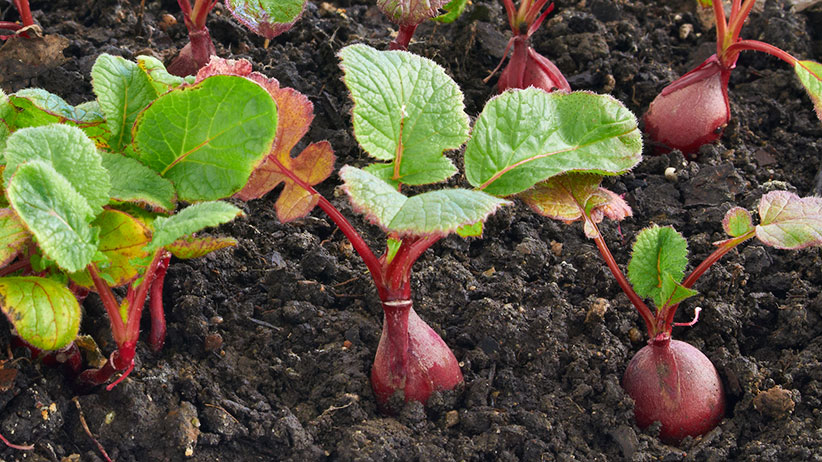
Radish (Rhaphanus sativus)
- Radishes may be prepared to reap round 4 weeks after germination.
- Don’t wait too lengthy to reap a radish. When sliced in half, a ripe radish can have a easy inside. An overripe radish can have a cracked inside.
- Strive rising ‘Spherical Black Spanish’. The distinction between the black outer pores and skin and white flesh is spectacular. The normally spicy white flesh turns candy when sauteed with slightly butter and herbs.
- For one thing totally different than the standard radish, develop daikon radishes (Raphanus sativus var. longipinnatus). This kind grows higher in sizzling climate and its white flesh is milder than a purple radish.
Radishes to Develop from Seed:
‘Watermelon’ radish seeds
Backyard Social gathering Radish seed combine
Crimson Crunch radish
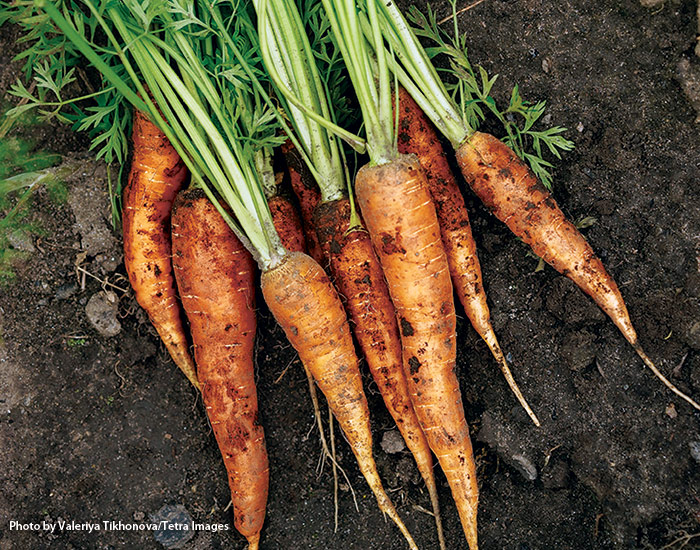
Ideas for rising carrots
Carrot (Daucus spp. and hybrids)
- Be affected person: Carrot seeds can take as much as 3 weeks to germinate.
- Take away the tops of carrots instantly after you harvest to assist the roots last more.
- On the finish of the season in fall you may “retailer” carrots within the floor by ready to reap them till you might be prepared. Simply unfold a 2- to 3-inch layer of mulch on high of the carrots to guard them. They’ll be high quality till the bottom freezes arduous.
There are 4 primary sorts of carrots:
| Identify | Description |
|---|---|
| Chantenay | Brief, large carrots; good for containers and poorer soil; good winter crop in heat climates. |
| Danvers | Medium-sized; greatest when harvested younger; tolerates poor soil higher than most varieties |
| Imperator | Medium-sized; commonest in grocery shops; want deep, wealthy soil |
| Nantes | Small to medium-sized; candy taste; not normally grown commercially |
Carrots to Develop from Seed:
‘Brief Stuff’ Chantenay carrot seeds
‘King Midas’ imperator carrot seeds
‘Bolero Nantes’ Crispy French Carrot seeds
‘Rotild’ Snacking Nantes carrot seeds
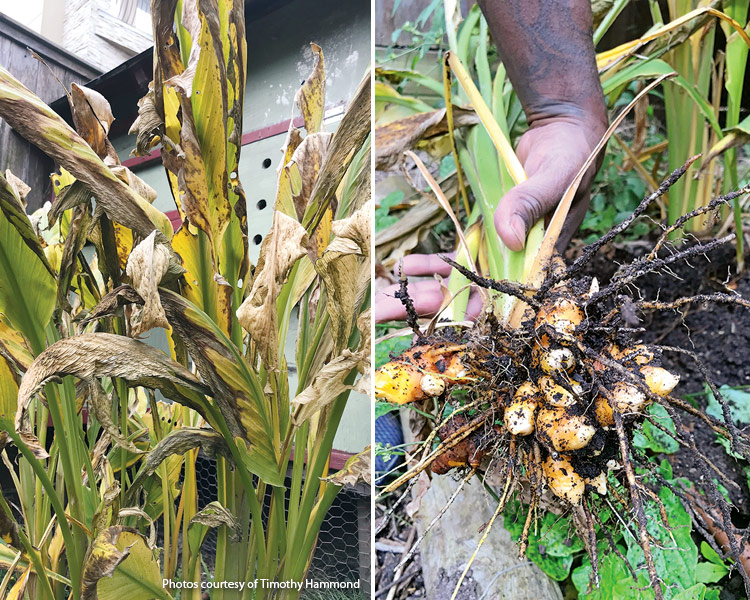
How you can develop ginger & turmeric
Two of my favourite root crops to develop are ginger and turmeric (above). The zing they add to dishes, the aroma, and most significantly, their well being advantages make them staples in my backyard. Listed here are 4 ideas for unmatched ginger and turmeric harvest. When you develop your individual, it will likely be arduous to return.
1. Select the most effective spot to plant
Like most root crops, ginger and turmeric choose free soil, closely enriched with natural matter. Keep away from planting in an space that doesn’t drain properly. This can trigger the rhizomes to rot. As soon as rising and established, vegetation can stand up to slight droughts however to get a much bigger yield, maintain the rising space or container properly mulched throughout the season. Select a spot in full solar.
2. Begin with high-quality ginger and turmeric rhizomes
I like to recommend shopping for rhizomes from an authorized natural supply. This manner it has not been sprayed with root inhibitor. These rhizomes promote out quick so I order in fall or winter. That stated, you may efficiently develop from grocery retailer rhizomes, too; I’ve loads of occasions however I at all times purchase natural and soak the rhizomes earlier than planting to take away any root inhibitor they could have been coated with. Ginger and turmeric rhizomes have bud factors, or eyes, the place the plant will sprout and start rising. You will have the choice of planting the entire rhizome or reducing it into 2-inch items. Enable these items to dry for a number of days to scab over earlier than you plant.
Sources for Ginger & Turmeric Rhizomes:
Baker Creek Heirloom Seeds
Southern Publicity Seed Change
Turmeric from Territorial Seed Firm
3. Plant, feed & be affected person
In zones 8 or hotter, plant the rhizomes outdoor within the spring and harvest in late fall. In zone 7 or colder rely again 10 months out of your common final frost date and plant the rhizomes indoors. Use a container that’s at the least 5 gallons and transfer it outdoor when temperatures are reliably above 70 levels. Whether or not you plant in a container or immediately into the backyard mattress, combine a slow-release fertilizer into the soil earlier than you plant and begin rhizomes about 8 inches aside and three inches deep. Make sure that the expansion buds are pointing up.Keep in mind to fertilize month-to-month—these vegetation are heavy feeders. If rising in a container, fertilize after a heavy rain, which tends to clean the vitamins out of the soil. When you plant, be affected person. I’ve began rhizomes in my backyard in early spring and never seen any development till midsummer. If vegetation sprout indoors, be sure you transfer them to a sunny window or put them below lights till they will go outdoor. You may develop turmeric and ginger in a container as small as 5 gallons, however I like at the least 15 gallons.
4. Harvest ginger and turmeric on the optimum time
When the foliage appears to be like just like the leaves turning brown above, it’s time to reap. If you’re rising in a container, this is so simple as overturning the container on a tarp to catch the soil, and selecting out the rhizomes. When you’re rising in a mattress, use a backyard fork to dig a circle across the inexperienced foliage, 2 to three ft away from the sprouts. This manner you decrease the danger of by accident damaging the rhizomes underground. After digging the roots, wash them off with a hose to take away as a lot soil as potential. Chances are you’ll even want a tender bristled brush to assist on this course of. Enable the rhizomes to air dry for a number of days earlier than consuming or preserving, and avoid wasting to replant the next yr.
You May Additionally Like:
Vegetable Backyard Companion Plantings that Actually Work
Downside-Fixing Backyard Books
Backyard Compost Fundamentals
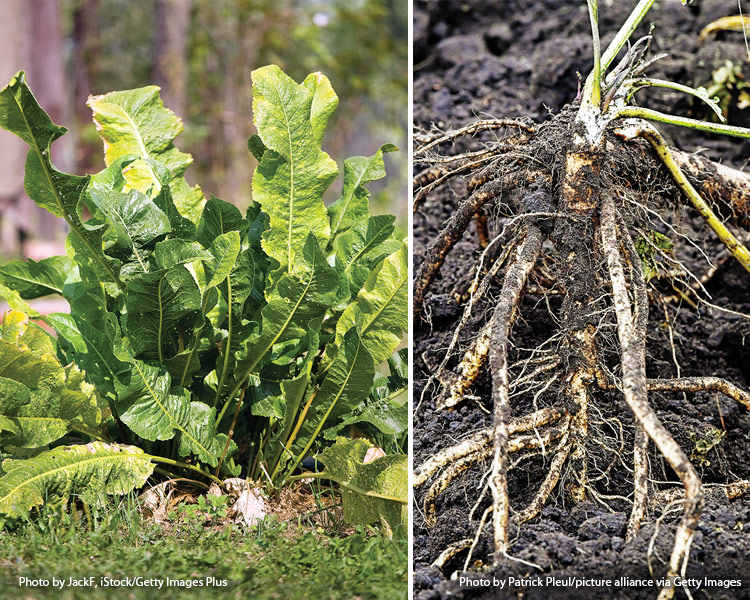
How you can develop horseradish
On the lookout for a brand new culinary ingredient to develop? Strive horseradish. This wide-leafed perennial has been cultivated for extra 3,000 years and thrives in cooler climates. Observe these 3 tricks to develop the final word horseradish.
1. Put together the soil
Horseradish prefers properly drained, loamy soils filled with natural matter. Previous to planting, loosen the soil right down to a depth of 8 to 10 inches and blend in an natural matter, comparable to compost or worm castings.
2. Plant the horseradish units
Horseradish is grown from units, or items of roots. In early spring begin with a set that’s about 10 inches lengthy and plant it vertically so the highest is 2 inches beneath the soil’s floor. One horseradish plant is greater than sufficient for a household. A plant will unfold about 30 inches in every route. In reality, it may be too aggressive in some gardens. If you’re involved about this, develop it in a pot to maintain it below management.
3. Harvest on the proper time
Horseradish is a perennial so it’ll come again in your backyard yearly. The very best taste and well being benefi ts come from roots which might be a few years previous. As soon as the primary frost has broken the foliage, dig a circle round the primary root with a backyard fork or spade. Dig deeply: You wish to harvest as a lot of every lengthy, slender taproot as you may with out breaking it. Each damaged piece left within the soil will sprout a brand new plant. I’ve made the error of not being cautious and ended up with horseradish all over the place in a mattress. (For this reason I now develop it in a container!) When you’ve harvested the roots, wash and dry them and retailer them in your fridge for up to a couple months till you’re prepared to make use of them.
Horseradish sources:
Huge Prime Horseradish from Renee’s Backyard
Horseradish Roots from Territorial Seed Firm
Horseradish roots from Johnny’s Seeds






